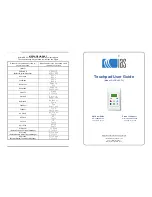
Maintenance
Calibration
6
6-3
Moisture Filter
The Bourdon tube sensor is hydroscopic. An external desiccant filter prevents
introduction of moisture and is strongly recommended for high humidity areas. The filter
should be replaced annually. The moisture filter is used with the reference port only
(absolute only instruments do not need a moisture filter).
Particle Filters
Refer to Appendix A for air supply quality requirements. During normal operation, the
PPI transfers gas both into and out of the device under test (DUT). When necessary, the
user is expected to use and maintain an in-line disposable particle filter to protect the
PPI’s pneumatics from any contamination that may exist in the DUT.
Vacuum Pumps
Periodic checks of the user’s vacuum pumps for oil levels. It is very highly recommended
that a power-down vacuum venting valve is installed onto the vacuum pumps to ensure
minimal chances of oil contamination from the vacuum sources. These are normally open
solenoid valves that are powered through the vacuum pump power switch. When the
vacuum pump is turned on, the solenoid valve is energized and closes allowing the pump
to operate normally. When the pump is turned off, power is removed from the solenoid
and the vacuum is vented to atmosphere. Periodic changing of vacuum pump oil should
also be done as recommended by the vacuum pump manufacturer.
Processor Battery
The processor board uses a lithium battery to maintain time and date information. This
battery has a varying life. If the instrument is left on 24 hours a day, it may last 5 to 10
years. If the instrument is stored, it may only last one year. Annual replacement is
recommended. To replace the battery:
1.
Turn off power and remove the instrument cover.
2.
Remove the processor card by removing the screw and the bracket that locks the
display cable in place and gently rock the card upward.
3.
Holding the processor card, remove the battery (the round silver object), by carefully
pulling on the battery.
4.
Plug in a new battery (part number 4-725).
5.
Reinstall the processor card, the bracket that locks the display cable in place and the
screw. Replace the instrument cover.
6.
The time and date may have to be re-entered. See Chapter 4, Menu; Menu
⎢
Setup;
Menu
⎢
Setup – System; Date/Time.
Calibration
To keep the PPI operating within its specified precision, the calibration procedure
described below should be performed once every year. If a higher level of overall
performance is desired, the user can calibrate more frequently.
Note
The calibration procedure automatically generates coefficients that are
stored in memory on the PPI. If these constants are “lost” for any reason,
the calibration procedure must be performed, regardless of the last
calibration date. If the calibration coefficients have been recorded, they
may be restored to the PPI at any time by “editing the coefficients.” (See
Chapter 6, Barometric Reference Calibration — Simulated Absolute.)
Summary of Contents for RUSKA 7050
Page 3: ...7050 Change Language Hold key for 5 seconds mode enter...
Page 4: ......
Page 10: ...RUSKA 7050 7050i 7050LP Users Manual vi...
Page 12: ...RUSKA 7050 7050i 7050LP Users Manual viii 7 1 Packing the PPI 7 3...
Page 18: ...RUSKA 7050 7050i 7050LP Users Manual 1 6...
Page 32: ...RUSKA 7050 7050i 7050LP Users Manual 3 4...
Page 60: ...RUSKA 7050 7050i 7050LP Users Manual 5 14...
















































